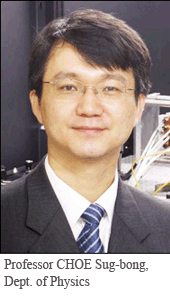 Professor CHOE Sug-bong found that nano-size particles could be reduced to the point where they exist in a blurred boundary between a two-dimensional and one-dimensional phase.
Professor CHOE Sug-bong found that nano-size particles could be reduced to the point where they exist in a blurred boundary between a two-dimensional and one-dimensional phase.
CHOE's research marks the first time that the dimensional crossover from a two-dimensional planar object and a one-dimensional line has been observed, as well as the critical point where the phase boundary ceases to exist.
Professor CHOE said the latest findings add detail to the complex picture of nature's universal laws in phase transitions, which regulate everything from the transition between vapor and liquid to changes in stock markets and earthquakes.
The discovery could also contribute to advancing emerging technology fields such as nano-sprintronics and developing new methods for producing nano-materials, he said.
``The research was conducted to improve our knowledge of nature's universality in controlling natural phenomenon, but the fundamental logic revealed in our study also offers possibilities for industrial applications,'' CHOE said.
``Nano-size objects used in electronic devices are getting smaller and smaller, and it's easy to predict that the nano-particles will be reduced in size to a point where they make the transition from the three-dimensional regime to a two-dimensional regime, and eventually a one-dimensional regime. However, scientists have been coming short of revealing exactly at what size the transitions occurs and the process of the transition, and our study provides an advancement in this area,'' he said.
The crossover to the one-dimensional regime occurred at a few hundred nanometers, which corresponds to the integration scale for modern nano-devices, CHOE said.
When the widths of the nano-wires were between 4.2 micrometers to 756 nanometers, the motions of domain walls retained the speed of a two-dimensional phase.
However, crossover behavior was first detected when the nano-wires were reduced to 500 nanometers in width, and at the 150-nanometer level particles began showing one-dimensional characteristics.
``We were surprised to discover that the two dimensional characteristics and one-dimensional characteristics co-existed when the nano-particles were between 500 nanometers and 150 nanometers in width,'' CHOE said.
``For this certain material, the crossover to the one dimensional phase occurred when it was reduced below 150 nanometers, while it retained two dimensional characteristics above 500 nanometers.''
This study was published in journal Nature on April 8.
April 14, 2009
SNU PR Office
SNU NOW
News
News
Dimensional Crossover in Nano-size Particles
Apr 14, 2009

